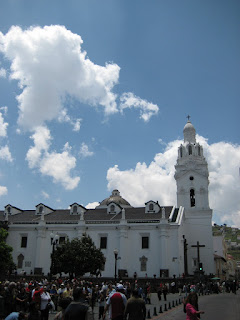
Meant to only spend a couple days in Quito, but ended up staying for 5 nights. Having too much fun in Quito with people from my hostal. Quito is a really beautiful city. As in any developing nation, there are crappy, dirty areas, but I am really surprised at how nice things are. I have been warned many times about how dangerous capital cities are in South America, but I have not felt unsafe or been in any kind of uncomfortable situation the entire time I spent in Quito.
Quito sits at about 9000 ft about sea level in a long valley surrounded by 14000 ft tall mountains. Spent my first day wandering around the old, colonial part of Quito and while doing so stumbled upon a changing of the guard ceremony at the presidential palace (which was pretty hoaky as these

types of ceremonies tend to be)
but the President of Ecuador, Rafael Correa was hanging out on his balcony watching. It was funny to watch the Quiteños (people from Quito) react to seeing him. Some absolutely detested him and were protesting him with large signs and chanting while others absolutely loved him and were getting onto their knees, in tears and shouting things like ¨Viva el presidente¨ (Long live the president). I can´t imagine many people in the US who love our current president so much that the sight of him would make them break into tears. But alas, I digress.


Another day I visited the Basilica del Voto Nacional and climbed up to the top of the tower, 80 meters above ground. One must climb several steep ladders (that would definitely be a liability issue in the US) to reach the top, however once braving the ladders, you are rewarded with sweeping views over the old part of Quito.

The same day I gave into the super touristy thing and took a bus to the ¨Mitad del Mundo¨or ¨Middle of the World.¨ It is essentially a monument at the equator and they have a line painted in the concrete so you can get a photo. Only problem is that they built the monument on the site where the French calculated the equator to be in 1700´s and with the advent of modern GPS, it has been determined that the French, and therefore the Ecuadorian monument, is off by 200 meters. Ooops. Anyways, the place was pretty gross and not worth the time to get there. All I got was a crappy, crooked picture.
Besides the old town, there is also a new part of town called the Mariscal Sucre, or ¨Gringolandia¨due to the large number of gringos. Most of the tourists stay in this area because of the massive amounts of tourist oriented lodging and dining options (I stayed in an area between the old town and the new town). Went out a few times with people from the hostel in Gringolandia and it was pretty fun. There were definitely lots of Quiteños out dancing along with the gringos and it was a pretty fun night. Met a bunch of people from the US, England and Australia who are living in Quito teaching English. It was interesting in that all the people from the US seem to have developed British accents, so much so that I was truly surprised to learn that these people were from places like Kansas City and San Francisco.
Anyways, Quito is a great place to visit. Lots to keep you occupied day and night. But I spent way more time here than I had planned.
To see more pictures from my trip, go to: http://picasaweb.google.com/jmellgren


 time in Medellin was paragliding over the city. Paragliding is where you are strapped to a parachute and fly around for a while. When I thought of paragliding, I always thought that since you were in a parachute you would take off from someplace with a really high elevation and then float down and land at a lower elevation, but the wind conditions in Medellin allow you to take off and land at the same spot.The wind conditions in Medellin make it one of the best places to go paragliding in South America and people come from all over to try it out here.
time in Medellin was paragliding over the city. Paragliding is where you are strapped to a parachute and fly around for a while. When I thought of paragliding, I always thought that since you were in a parachute you would take off from someplace with a really high elevation and then float down and land at a lower elevation, but the wind conditions in Medellin allow you to take off and land at the same spot.The wind conditions in Medellin make it one of the best places to go paragliding in South America and people come from all over to try it out here. nervous before setting off (running off a mountain isn´t something I do every day) but everything turned out great. The ride was very smooth and I was in the air for the tandem flight over Medellin for about 45 minutes. The only downside to the paragliding is that while we were waiting to get everything set up, we got tons of sand flea bites on our feet and ankles and they have been itching like crazy ever since. Oh well.
nervous before setting off (running off a mountain isn´t something I do every day) but everything turned out great. The ride was very smooth and I was in the air for the tandem flight over Medellin for about 45 minutes. The only downside to the paragliding is that while we were waiting to get everything set up, we got tons of sand flea bites on our feet and ankles and they have been itching like crazy ever since. Oh well.
















































